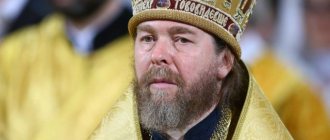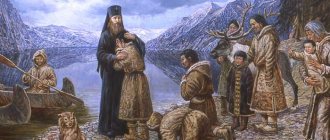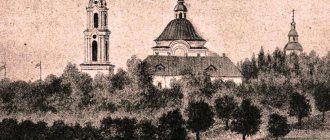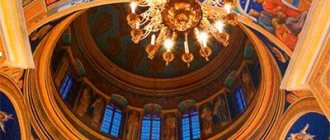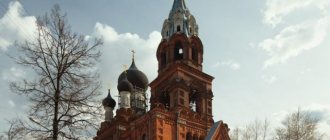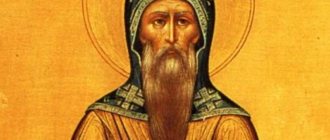Life of St. Tikhon of Medyn, Kaluga
Over many years spent away from people in strict asceticism, the Reverend cleansed his soul of sinful passions and achieved deep spiritual peace. Being in constant vigil and unceasing prayer, performing difficult monastic feats, he was able to acquire by the grace of God “the fruits of the Spirit: love, joy, long-suffering, kindness, mercy, faith, meekness, self-control” (Gal. 5: 22-23).
Just as “a city standing on top of a mountain cannot hide” (Matthew 5:14), so our holy father Tikhon could not hide from people. As the monastery legend tells, after a while the surrounding residents learned about his place of residence and glorious exploits. Rumor began to spread about the unusual forest hermit. Soon people began to come to him for spiritual advice and consolation, bearing their sorrows and everyday hardships. At the same time, disciples gathered around the Reverend, attracted by his ascetic life. With the blessing of the humble old man, they began to settle next to him. One of the first disciples of the holy father was the Monk Nikifor, later the founder of the Spasskaya Hermitage (Spaso-Vorotynsky Monastery), at the mouth of the Ugra.
From the lives of the reverend Fathers of the Church, it is known that those who struggle as they grow spiritually experience increasing temptations. When the enemy of our salvation, the devil, sees that he himself cannot interfere with the virtuous life of an ascetic, then he uses evil people as his tools. A similar thing happened with the Reverend.
One day, the prince, the owner of the Medyn lands, while driving around while hunting in the forest, unexpectedly met with the Monk Tikhon and his disciples. Anticipated by malicious rumors and not wanting a monastic monastery to be formed on his estate, he angrily ordered the hermit to immediately leave the princely domain. Humbly enduring reproaches and threats, the saint of God prayed for the prince who offended him, knowing from spiritual experience that “evil can only be overcome by good” (Rom. 12:21). To top off the insults, incited by the devil and inflamed with anger, the enraged prince swung his whip at the holy father. But an amazing miracle happened. Suddenly the power of God, which “is made perfect in weakness” (2 Cor. 12:9), stopped his raised hand, making it motionless. Frightened by this punishment, the prince repented of his sin, asked for forgiveness from the Monk Tikhon, and through his prayers received spiritual insight and physical healing. Enlightened from above, having turned his anger into mercy, the prince himself now began earnestly to beg the holy elder to establish a monastic monastery in his domain and promised to supply it with everything necessary. After praying, the Monk Tikhon accepted this offer.
Not far from the gigantic oak tree, he and his students cut down a small wooden church in honor of the Dormition of the Blessed Virgin Mary, and also built several simple cells. Soon the brothers cleared the forest from the land, surrounded the clearing with a wooden fence, and cultivated the land for vegetable gardens. Thus began the outwardly harsh, but spiritually blessed monastic life of the new holy monastery in Rus', later called Tikhon’s Hermitage.
The Monk Tikhon continued his spiritual feat at the new obedience of the abbot of the monastery. At the persistent requests of his disciples, as well as for the regular celebration of the Divine Liturgy, the Reverend accepted holy orders. Having many virtues and especially the gift of reasoning, the holy abbot became a wise and kind father for the brethren. The humble elder taught his students monastic life not only with teachings from books, but most often by personal example, based on his many years of experience living in the desert. He treated the brethren like a father simply, with humility, with meekness, comforting and strengthening them in temptations. Having a merciful and kind heart, the holy saint of God received strangers, fed the hungry and helped the poor. As it is said in the akathist to St. Tikhon, he was a mentor to his disciples, corrected them with humility, had a meek disposition, acquired a kind heart, fed the hungry, gave water to the thirsty, gave mercy to those who asked, performed many miracles with the grace of the Holy Spirit, healed the sick, the blind and the lame, drove away evil spirits. According to ancient monastic tradition, shortly before his blessed death the Reverend was tonsured into the great schema.
About the appearance of the Monk Tikhon of Kaluga, evidence was preserved in the “Iconographic Original”, under April 10: “Our Rev. Father Tikhon, the head of the monastery of the Theotokos, also in Kaluga, in the likeness of the head, the brad of Vlasiev, the venerable vestments and in the schema.” It is interesting that the iconographic image of Saint Tikhon completely coincides with the description of the appearance of this saint of God, recorded in 1842 from the words of the peasant woman Alexandra Grigorievna Zhalnova, a widow from the village of Bogoroditsk, Kaluga province. This sick woman, being paralyzed, lay on her bed for 12 years and had never before seen an iconographic image of St. Tikhon of Kaluga. On June 15/28, on the eve of the saint’s memorial day, he himself appeared to Alexandra Zhalnova. She saw a short, thin old man walking towards her, with a small gray beard. He was dressed in a long black robe (monastic mantle), on his head was a kind of round cap on which green crosses were embroidered (schema doll). The elder healed the paralytic woman, telling her that his name was Tikhon the Reverend from the desert and he lived 17 miles from Kaluga.
The peaceful monastic life of the newly founded monastery was disrupted in 1480, when the famous “Standing on the Ugra River” of Russian and Tatar troops took place a few kilometers from the monastery. Through the intercession of the Most Holy Theotokos, the prayers of our venerable father Tikhon and many Russian saints, the numerous troops of the Tatar Khan Akhmat, having failed to defeat the regiments of the Great Moscow Prince Ivan III, were forced to leave the Russian lands. This significant historical event served as the final liberation of Rus' from the Tatar yoke and became the beginning of the creation of an independent Russian state. In memory of this event, today the monastery founded the Vladimir monastery with a temple in honor of the “Vladimir” Icon of the Mother of God, and on the territory of the monastery a museum complex-diorama “The Great Stand on the Ugra” was created.
The Monk Tikhon, “shining through his life with holiness,” having lived to a ripe old age, adorned with gray hairs of age and spiritual wisdom, had long desired to move to the heavenly abodes. And then, on June 16/29, 1492, this long-awaited day came. Lying on his deathbed, the first abbot of the Tikhon monastery said goodbye to his disciples, gave them his last instructions and blessings, and peacefully departed to the Lord. The soul of the gracious elder passed into another better world in order to taste the fruits of his earthly labors, to stand before the throne of God for the brethren of the monastery and for all who with faith turn to him in prayer.
Saint Tikhon's successor was his disciple, the Monk Nicephorus. The celebration of the day of memory of the Monk Tikhon began in the monastery shortly after his blessed Dormition, and was approved by the Moscow Council of 1551, at which the saint of God Tikhon of Kaluga was canonized. According to monastic tradition, for a long time the holy relics of the founder of the Tikhon Hermitage rested openly in the Assumption Church, but in the Time of Troubles (1610), for the sake of their preservation, they were hidden deep in the ground under a bushel, where they rest to this day.
For his ascetic and godly life, the Monk Tikhon was awarded the gift of miracles from the Lord. Many miracles were and are being performed in our time at the shrine over the relics of this holy father, as well as at the healing spring he dug. And today everyone who prays with faith to the Saint receives healing and quick help in all their needs through his intercession to our Lord Jesus Christ, to whom be glory forever and ever. Amen.
years of education
In 1728, Timothy was enrolled in a religious institution, which two years later became known as a seminary.
The young man was distinguished by his ability to learn and soon earned a transfer to free education. However, Timofey continued to be in need and sold half of his rations to buy candles. Some students from wealthy families mocked his poverty, but the young man did not hold a grudge and continued his humble self-education.
- Timofey stood above all his peers and successfully passed exams for 14 years. Here he became skilled in grammar, rhetoric and theological philosophy. The duration of training was due to the small number of teachers in the theological seminary. The future saint completed his studies in 1754.
- He received the position of teacher of Greek, as well as rhetoric and philosophy. Timofey was remembered by everyone as a modest, friendly teacher and a man of pious character.
- During this period, the future saint gravitated more and more towards the Lord, studied the Holy Scriptures and strove for contemplation of God. Those around him noticed: in this man a great spiritual personality was maturing, who would be destined to revive the authority of religion in an atheistic age.
- Tikhon of Zadonsk made the final decision about monastic life after the sign in heaven.
On a note! The saint was one of the few monks who supported the desire to be honest and observe moral principles. His words never conflicted with subsequent accomplishments, and his thoughts never conflicted with integrity.
Period of monasticism
In April 1758, Timofey took monastic vows and received the name Tikhon. After this event, the clergy sent him to St. Petersburg, where the saint received the rank of hieromonk. At the local seminary, Tikhon taught philosophy and received the post of prefect.
Saint Tikhon the Wonderworker of Zadonsk
- After a year of work in St. Petersburg, he was appointed archimandrite of the Zheltikov Cathedral in the Tver province. At the new place, my father taught a theological subject and served as abbot of one of the monasteries.
- The saint advanced quite quickly in his spiritual career. Many brothers appreciated his pious, humble disposition and prophesied for him the highest rank of bishopric.
- For two years Tikhon Zadonsky taught at the Tver Theological Seminary. During this period, his book was published, describing the principles of true Christianity, where general edification was outlined for the Russian Orthodox tradition.
- Tikhon himself never thought about the highest rank of monasticism, but the Lord had other plans, and He ordered that the saint be elevated to the place of spiritual teacher of the entire state.
- Soon the ceremony of choosing a new bishop took place. At first, Tikhon's name was not included in the list of candidates because he was young enough to receive the highest rank. However, the archimandrite from Smolensk persuaded the meeting to accept the candidacy of the Tver rector. The lot was cast three times, and each time the name of St. Tikhon came up. The meeting agreed that fate and God were on the side of the young priest.
- At the age of 37, Tikhon became a bishop. He preached Christian doctrine and encouraged the brethren and parishioners to wake up from the deep sleep imposed by the present age.
About other saints of the Orthodox Church:
- Spiridon Trimifuntsky
- Prayer of St. Philaret of Moscow
- Akathist to Saint John of Shanghai
Interesting! In Voronezh, they continued to celebrate a holiday glorifying the pagan deity named Yarilo (the sun god of the Slavs). This celebration earned an unpleasant reputation due to the outrages and disgusting behavior of the celebrants. Saint Tikhon personally appeared on this holiday and publicly denounced all those who behaved immorally. His words had a perfect effect, and this celebration was stopped.
Finding the relics
Before his death, Tikhon of Zadonsk asked the Lord about the exact time of his death, and the answer came in the morning. The Almighty promised the saint entry into the Heavenly abode in three years. After this, the elder retired to his own cell, liturgical vestments and a coffin were prepared for him, in front of which he often shed tears.
One day, after a divine dream, Tikhon felt ill, his left cheek and leg stopped working. The monk accepted the illness with sincere joy. The death became clear after a dream in which the people helped Tikhon climb the stairs to the kingdom of God.
In August 1783, at the age of 59, the saint passed away. The remains, which performed various miracles, are kept in the Vladimir Church. The canonization of Tikhon of Zadonsk took place 88 years after his peaceful death.
Prayers
Troparion, tone 8
From your youth you loved Christ, O blessed one, / you were the image of everything in word, life, love, / spirit, faith, purity and humility, / and you also dwelt in the heavenly realms believers,/ where we stand before the Throne of the Most Holy Trinity, // pray to St. Tikhon , save our souls.
Troparion, tone 4
Teacher of Orthodoxy,/ teacher of piety,/ preacher of repentance,/ Chrysostom zealot,/ good shepherd,/ new Russia, luminary and miracle worker,/ thou hast shepherded thy flock well/ and With your writings you have instructed all of us,/ also adorned with the crown of incorruptibility/ from the Chief Shepherd, // pray to Him to save our souls.
Kontakion, tone 8
The successors of the apostles, the adornment of the saints, the teacher of the Orthodox Church, the Lord of all, pray/ to grant universal peace/ and great mercy to our souls.
